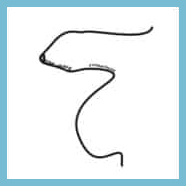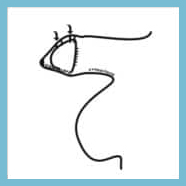Here at Intramed Medical Centre in Calgary, our doctor performs Pollock Technique™ circumcision, including use of a Mogen clamp and adequate local anaesthetic methods.
For newborns and babies, extensive pain control methods are employed, including Tylenol before the procedure, an oral sugar solution (which has been shown to reduce pain perception) and a quick & long acting local anesthetic.
Contact us for more information or to schedule an appointment for circumcision.
The Pollock Technique™ can be used for babies, teens and adult men, and consists of using a Mogen clamp under long-acting local anesthetic.
Intramed currently offers Pollock Technique™ circumcisions for infants up to 4 months of age, for teens age 13 and up, and any adult male. The Pollock Technique™ circumcision operation takes only a minute for newborns.
We feel that Pollock Technique™ circumcision is an effective and gentle procedure for infants, teens, and men. Only local anesthetic is needed and recovery time is relatively fast.
We routinely provide circumcision for teens who are 13 and up, as well as adult circumcision for men of any age.
Our method is fast, and has proven safe over the past 25 years. This is one of the reasons why so many physicians refer their patients to our clinic.
Request Information
The Pollock Technique™ used here at Intramed by our doctor is based on the Mogen technique. This technique is known for its quickness and safety. In conjunction with this technique, our doctor uses the most complete and extensive pain control methods available. This ensures that your son will feel little or no pain at all.
The entire circumcision (including bandaging) takes under 60 seconds. To calm the baby during the procedure, a sugar filled gauze pacifier soaked with sweet juice is used, as well as sufficient local anaesthetic.
The objective of the Pollock Technique™ is to minimize stress on the infant and family via maximum pain control and a quick and simple procedure.



An infant circumcision is often undertaken for cultural and religious reasons, and there can be health benefits as well:
In some Alberta families circumcision is simply a family tradition, with sons following the lead of the father.
Some mothers prefer circumcision to reduce the risk of infection in their baby and over the life of their sons.
Circumcision is a simple operation that involves removal of the foreskin that sheaths the head of the penis. There are a number of very different methods used in Alberta today for circumcision and the application of anesthesia.
The Pollock Technique™ for infant circumcision allows for a virtually painless and bloodless procedure to be safely performed in under 60 seconds. This technique was developed by Dr. Pollock and is used exclusively by our doctor, who has trained extensively with Dr. Pollock and has mastered the Pollock circumcision procedure.
Circumcision is associated with few and infrequent complications, although with any surgical procedure there are occasional problems. For example, bleeding. In almost all cases bleeding is controlled by direct pressure. The frequency of complications after infant circumcision varies with the skill and experience of the physician amongst other factors.
Even though complications are rare, do not hesitate to consult with our doctor if you have any questions about the appearance of the penis. Remember, early treatment (if any is needed) is always the optimal solution. We safely perform over a thousand circumcisions every year and are familiar with all potential issues and we will be pleased to speak with you anytime about any concerns you have.
Please read on below for detail on potential (but unlikely) issues and how to react should they occur.
Please check your baby’s diaper for any bleeding every hour for the first 24 hours after circumcision. If the baby is sleeping, you can just look at the front edges of the diaper from the outside. If it is not discolored, he is likely not bleeding abnormally. When you open the diaper, it is normal for the covering gauze to be a little red from bleeding.
You treat bleeding from the penis the same as you would for the tip of a finger:
It is reasonable for you to try the pressure technique twice, for 2-3 minutes at a time, before calling the doctor as most bleeding will stop with this.
TIP: Never wipe a wound with gauze, cloth, etc. This may only dislodge a clot on the wound surface causing renewed oozing or bleeding.
It is better to gently dab or apply gentle pressure on the healing wound surface. If the penis is dripping any blood and you cannot stop the bleeding with the pressure technique, call our doctor immediately.
When the length of the penile shaft is no greater than its diameter or when there is a good amount of pubic fat, the penis will tend to retract inward. This is normal. This characteristic is only a concern for the first month or two since the healing circumcision can adhere to the surrounding skin resulting in what is called a “concealed penis”.
If your son fits this profile, you can reduce the chance of concealed penis by applying a very thin layer of Vaseline to the entire glans, once a day, until the glans takes on a healed appearance (about 1-2 months).
To expose a glans that has retracted inward, place gentle downward pressure on either side of the base of the penis.
Consult the doctor if the penis cannot be fully exposed, or if any connecting skin bridges form between the shaft skin and the head of the penis.
Although rare, there have been reported cases of infection. Common signs of infection include: a pus like discharge, a foul smell, excessive swelling or redness, local warmth, a fever, or a rash anywhere in the area of the penis.
With any of these signs, or if your son has not urinated in over 12 hours, consult our doctor immediately.
Request a Circumcision Appointment
There will be a long gauze strip (1/2×8 inches) wrapped around your son’s penis. This strip may fall off within the first 24 hours. When it does, do not attempt to replace it. If it falls off early, do not worry, leave it off. You can place the small gauze given to you at our office (with some Vaseline on it) on the penis for the remainder of the 24 hours period. If after 24 hours the gauze bandage is still in place, it will have to be removed.
To remove the gauze strip:
If the bandages won’t come off, call our office to book an appointment ASAP so the doctor can remove it for you.
Keep in mind the following things:
If you have any other comments or questions, do not hesitate to call the office.
Quick Contact
Call now: 403 255 6196 | CONTACT US
3223 17th Ave. SW,
Calgary, AB, T3E 7S1

We acknowledge the traditional territories of the people of the Treaty 7 region in Southern Alberta and the Métis Nation of Alberta (Districts 5 and 6).